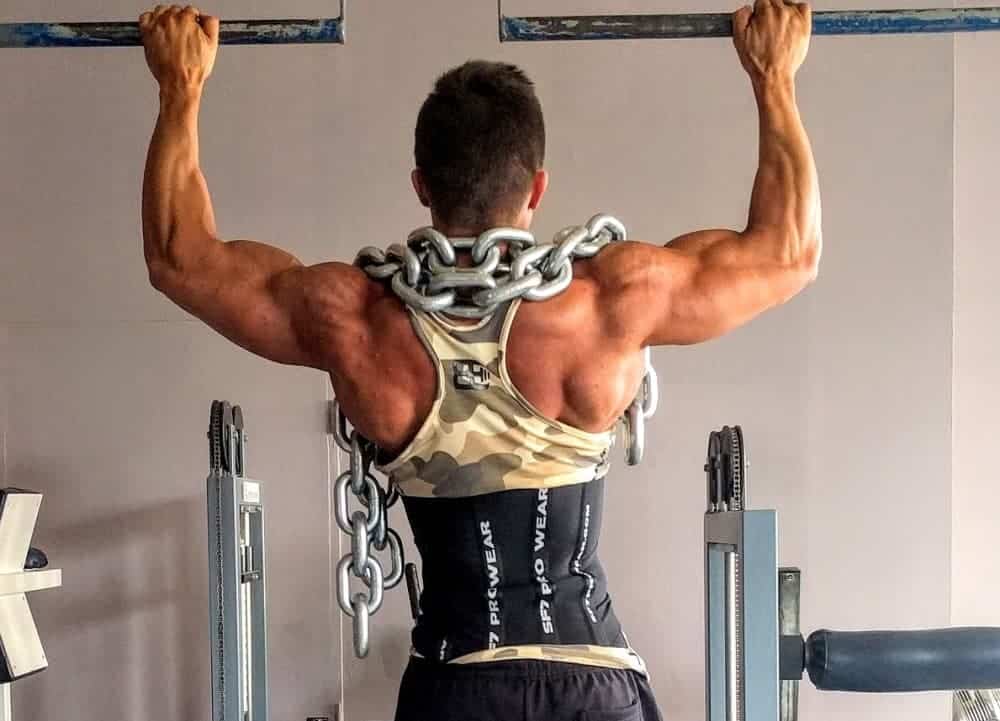You want to have big and massive traps?
But what exercises do you choose from?
How often and intense should you train to get the most out of your trap workout?
If these questions sound somewhat familiar, then this article about the optimal traps volume is what you’re looking for!
Big traps are associated with masculinity. There are only a few things that embody more masculinity than a pair of trap mountains that reach to your ears.
Don’t worry, we’re not talking literally here, at least for my traps though…
Unfortunately, for most lifters, exercising trap muscles merely consists of a few faltering sets of dumbbell or barbells shrugs at the end of their back or shoulder workout.

This is unfavorable from an aesthetic and functional point of view.
The traps play an important role in the prevention of shoulder and neck injuries, as well as helping to improve overall performance.
With this in mind, I think it is pretty self-explanatory why you should overthink your traps workout.
However, you don’t need to spend years on them.
In the following, you will see that the whole concept is relatively straightforward to convert into practice.
Let’s get to work, guys.
MV – Maintenance Volume
What does MV mean?
MV refers to Maintenance Volume which indicates the amount of work that is required to maintain your muscle’s current size.
To put it in other words, the amount of volume required to avoid losing any gains. We’re not growing yet but maintaining.
And why is it important to know your MV?
Let me answer this question with a counterquestion.
If you have to fall back from training for a certain period, do you want to lose your hard acquired muscles?
Obviously, nobody wants that. Anything else would be against common sense…
What’s more? After a period of heavy workouts in between your MAV and MRV or even above, you should take some rest from time to time.
Certainly, it’s a good thing, or sometimes even indispensable, to lower your volume.
This will help to desensitize your body and enable it to fully recover.
Such phases where you lower the overall volume after heavy and exhausting weeks of your mesocycle are so-called “deload” phases.
Oftentimes one mesocycle consists of 4-5 weeks. For example, starting off with your MEV in week 1 and increasing volume over the next weeks. Until you probably overreached your MRV at the end of week 4.
Now, after your progress begins to stagnate or even decrease, it’s time to take a break. Notice, if you don’t feel sore or depleted, it’s not mandatory and even better to continue training sometimes as you would waste valuable grow time otherwise.
Nevertheless, sometimes it is also inevitable to use deloads preemptively to avoid getting into overtraining.
On average, in a deload week, you reduce the weights by 40-50% keeping the number of sets even but within higher rep ranges. So overall training is lighter to leave passive structures in some room to recover.
If that still leaves some questions open concerning deloads, I recommend you to check out my article about deloads. Just click the previous link to get more in-depth.
Moreover, it’s indispensable raising variation by exchanging exercises over time to stimulate new incentives.
You cannot train with the same exercises all year long. After a while, your body becomes familiar with it. And that’s the principle of muscle hypertrophy, creating new stress consistently.
For beginners, try to vary between exercises every 2-3 mesocycles. Advanced athletes can even switch exercises every mesocycle.
Concluding, it is crucial to know what the MV is and what you can use as benchmarks to ensure you don’t lose any muscles.
Also, something notably important that gets underestimated a lot, is keeping the volume in your “deload phase” appropriate.
Some folks tend to train “too heavy” in their deload week.
I find myself in a similar situation, trust me. But aiming for the best results and enhanced performance, we need to obey the rules.
What’s the MV for the optimal traps volume?
MV: 0 sets/week
How is that possible?
First of all, this concerns isolated work, which gives a total amount of 0 required isolated sets/week to maintain your trap’s current size.
As we already discovered for other muscles like front delts, glutes and smaller muscles like that, they get involved through your normal training program.
Especially exercises like rows, lateral raises and basically almost every back or shoulder exercises hit the traps to some extent.
Even squats and stiff-leg deadlifts involve traps.
Thus, your traps can for sure maintain their size with no direct isolation work at all.

MEV – Minimum Effective Volume
What does MEV mean?
Minimum Effective Volume relates to the least amount of work that is necessary to stimulate some muscle growth.
Why is it important to know your MEV?
To put it in a nutshell, just like it’s important to know how much volume your traps need to maintain its current size, it is at least of similar importance to know how much volume you need to grow your traps.
So, what’s the MEV for the optimal traps volume?
MEV: 0 sets/week
How is that even possible? The same value for maintenance and minimum effective volume?
As above-mentioned, with your normal workout routine, you get so much trap involvement that they can grow fairly big from that.
Does that mean I can get big traps without any direct isolation work?
It might sound too good to be true, but that’s exactly the point.
Now you know why I said “you don’t need to spend years on them” in the beginning.
But, of course, big traps can always get bigger;)
I hope I don’t disappoint you now, but for traps maximization, we surely need to put more effort in.
The optimal traps volume doesn’t randomly appear, it’s about your personal progress, experiences, and consistency.
MAV – Maximum Adaptive Volume
Carrying forward what I just said, with the MAV we’re able to get big traps even bigger.
What does MAV mean?
In short, MAV relates to the Maximum Adaptive Volume.
This reveals the amount of work where probably most of the muscle growth will happen, on average.
Why is it important to know your MAV?
Do you want to limit your potential to the least effective growth?
Exactly, I don’t think so. Nobody wants that.
Therefore, more effort is required for our workout and to increase the volume consistently over time. This is likely to get us into the area where maximum growth happens.
That’s why it is important to know what the MAV is, and which benchmark you can use as a point of reference.
What’s the MAV for the optimal traps volume?
MAV: 12-20 sets/week
If you just want your traps to be relatively balanced, or focus your first years on the bigger body parts, you don’t need any of these MAV and MRV volumes.
Traps really take care of themselves.
Albeit, if you want to add more and more size to your traps, between 12-20 sets/week is the way to go for you.
MRV – Maximum Recoverable Volume
What does MRV mean?
MRV stands for Maximum Recoverable Volume.
It refers to the maximum amount of work that your body is able to fully recover.
In other words, the maximum amount of work that your body can sustain until your strength and performance might even decrease.
Sooner or later in your mesocycle program, you will reach a point where progress isn’t going as smooth as it used to be.
Performance starts to stagnate. Everything just doesn’t feel as hassle-free as before.
Oftentimes, this is an indication that you most likely overreached your MRV.
Wait a minute… Overreaching? What is that supposed to mean?
Don’t worry. I wrote a whole article that covers this topic, just click the highlighted link.
Why is it important to know your MRV?
If we think about the above-mentioned aspects, it seems logical.
Who wants to take superfluous breaks from training?
Exactly, nobody. At least I hope so, guys… 😉
All things considered, it’s important to know your MRV to avoid redundant breaks and overreaching too quickly.
And how much volume on average can most people’s traps sustain?
MRV: 26 sets/week
Wow… that sounds a lot, right?
Don’t panic, here’s the deal.
As well as it’s very easy to maintain or stimulate your traps to grow, it similarly easy to train them.
Firstly, training traps isn’t hard when done properly.
Secondly, traps are in charge of holding the shoulder girdle which is why they can sustain a lot of pressure.
Thirdly, because traps are involved in a lot of exercises, so they can recover relatively fast as well.
Consequently, considering these three points it becomes clear that the MRV value can be as high as 26 sets/week.
Finally, before we continue, I want to emphasize it once more. If you only want to grow your traps, you actually don’t need to train your traps directly.
However, if you want to have the best traps possible, then you definitely need to work on them.
Frequency
How often should I train them for the optimal traps volume?
2-6 workouts/week
In fact, traps heal relatively fast which is why you can train them between 2 up to 6 times/week.
If you really don’t care about traps, stay with 0 times/week, they will grow without any direct work to at least some extent.
But, if you want to focus on your traps, work up to 3-4 times/week and you’ll get the maximum benefit.
This varies individually since some people might even able to go 6 times/week whereas others struggle with 3-4 times/week.
Try out different things and track your progress over time to assess what works best for you.
Intensity
What about intensity? How often can and should we train them for the optimal traps volume?
10-20 reps/set
This is on average the rep range that works best for most individuals.
Why isn’t it any lower?
Because, as mentioned in the beginning, deadlifts, stiff-leg deadlifts, and rows hit the traps quite intensively.
Oftentimes, what you’ll deadlift is a weight that you cannot even shrug for a single rep.
So, when we’re training traps it will be mainly in between 12-20 reps. We save the heavy work for compound exercises like deadlifts and stuff.
Traps workout – Exercises
What’s the best exercise for big, massive traps?
As always and because everybody is unique, it’s mainly about personal preference and your anatomy.
But, nevertheless, I’ll give you some good example of common and my personal favorite exercises for traps.
- Barbell Deadlift (variations)
- Barbell Shrugs (or Dumbbell)
- Barbell Row (or Dumbbell)
- T-Bar Row
- Upright Rows
- Seated Cable Row (grip variations)
- Face Pulls (variations)
- Lateral Side Raises
- Reverse Flys (Cable or Dumbbell)
- Butterfly Reverse
With all these exercises, there are a lot of different variations.
It’s for sure a good thing to integrate exercises with more than one variation into your trap workout to stimulate as much muscle fibers as possible.
There is no best or worse exercise. Make sure to try all of them and figure out which one suits you the best.
Range of Motion
What about Range of Motion for trap training?
Execution is the key. That’s very straightforward but true for bodybuilding in general.
You definitely want to make sure that every time and every rep, you get your traps fully stretched.
It doesn’t matter which angle you’re pulling from, mind to go all the way up and all the way down.
Never sacrifice full range of motion and proper contraction for weights that are too heavy for you to control.
Conclusion
To conclude, there’s not a lot of secrets and tricks to trap training.
If you want bigger traps than your actual workout routine has already given you, start with 2 times/week of direct trap work and work your way up.
If that does not sound appealing to you, then don’t.
Traps are not the most important muscles to focus on and they still grow without any direct work which is pretty convenient for those of you who don’t really care about traps.
Let’s sum up today’s most important keynotes for the optimal traps volume.

Exercises: There is no best or worst exercise. Make sure you switch between them to increase variety after some time.
Some of the most common exercises for traps are all kind of rows, deadlifts, shrugs and reverse flys.
Because there are a lot of different angles for all these movements, integrate some diverse angles to stimulate as much muscle fibers as possible.
Range of Motion: Execution is key. Make sure to always get a full stretch of your traps. Go all the way up and all the way down for the optimal traps volume.
Never ever sacrifice a full range of motion for heavyweights that you cannot control properly.
Practical Tips
Regarding trap training, there are no particular helpful techniques.
But, nevertheless, you can use supersets or drop sets now and then.
For more in-depth information, check out the highlighted links for full articles that I wrote about each topic.
Special shout-out to Dr. Mike Israetel, we really value his knowledge and the content that he shares with us on his YT channel and his blog.
Definitely check out his video about traps volume!
Do you prioritize your traps?
Thanks for tuning in, guys, I hope you enjoyed this article about the optimal traps volume.
For feedback or any questions, leave a comment below or feel free to contact us.
Cheers,
Claas






1 thought on “The Optimal Traps Volume – Hypertrophy Guide”
Hello there, I found your blog via Google at the same time as looking for a
related matter, your website got here up, it appears great.
I have bookmarked it in my google bookmarks.
Hello there, simply become alert to your blog thru Google, and found that it
is truly informative. I’m going to watch out for brussels.
I’ll appreciate in the event you proceed this in future.
Numerous other people shall be benefited out of your writing.
Cheers!